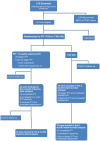Interpersonal psychotherapy versus treatment as usual for PTSD and depression among Sichuan earthquake survivors: a randomized clinical trial
- PMID: 25254070
- PMCID: PMC4172897
- DOI: 10.1186/1752-1505-8-14
Interpersonal psychotherapy versus treatment as usual for PTSD and depression among Sichuan earthquake survivors: a randomized clinical trial
Abstract
Background: Without effective treatment, PTSD and depression can cause persistent disability in disaster-affected populations.
Methods: Our objective was to test the efficacy of Interpersonal Psychotherapy (IPT) delivered by trained local personnel compared with treatment as usual (TAU) for Posttraumatic Stress Disorder (PTSD) and Major Depressive Disorder (MDD) among adults affected by the Sichuan 2008 earthquake. A small randomized controlled trial of IPT + TAU versus TAU alone was delivered by local mental health personnel in Shifang, China. Between July 2011 and January 2012, 49 adults ≥ 18 years with PTSD, MDD or both were enrolled and randomized to 12 weekly sessions of IPT + TAU (27) or TAU (22) alone x 12 weeks. IPT was then offered to the TAU group. Unblinded follow up assessments were conducted at three and six months. IPT was a 12 session, weekly one hour treatment delivered by local personnel who were trained and supervised in IPT. TAU was continuation of prescribed psychotropic medication (if applicable) and crisis counseling, as needed. MAIN OUTCOME(S) AND MEASURES (S): Clinician Administered PTSD Scale (CAPS) PTSD diagnosis; Structured Clinical Interview for DSM-IV (SCID) for MDD diagnosis. Secondary measures included PTSD/depression symptoms, interpersonal conflict/anger, social support, self-efficacy and functioning.
Results: Using an intent-to-treat analysis, 22 IPT + TAU and 19 TAU participants were compared at three months post-baseline. A significantly greater reduction of PTSD and MDD diagnoses was found in the IPT group (51.9%, 30.1%, respectively) versus the TAU group (3.4%, 3.4%, respectively). Despite the small sample, the estimates for time-by-condition analyses of target outcomes (2.37 for PTSD (p = .018) and 1.91 for MDD (p = .056)) indicate the improvement was better in the IPT + TAU condition versus the TAU group. Treatment gains were maintained at 6 months for the IPT group. A similar treatment response was observed in the TAU group upon receipt of IPT.
Conclusions: This initial study shows that IPT is a promising treatment for reducing PTSD and depression, the two major mental health disorders affecting populations surviving natural disaster, using a design that builds local mental health care capacity.
Trial registration: ClinicalTrials.Gov number, NCT01624935.
Keywords: Depression; Disaster; Domestic violence; Earthquake; Mental health; Posttraumatic stress disorder.
Figures


Similar articles
-
Interpersonal psychotherapy delivered by nonspecialists for depression and posttraumatic stress disorder among Kenyan HIV-positive women affected by gender-based violence: Randomized controlled trial.PLoS Med. 2021 Jan 11;18(1):e1003468. doi: 10.1371/journal.pmed.1003468. eCollection 2021 Jan. PLoS Med. 2021. PMID: 33428625 Free PMC article. Clinical Trial.
-
Interpersonal psychotherapy for depression and posttraumatic stress disorder among HIV-positive women in Kisumu, Kenya: study protocol for a randomized controlled trial.Trials. 2016 Feb 3;17:64. doi: 10.1186/s13063-016-1187-6. Trials. 2016. PMID: 26841875 Free PMC article. Clinical Trial.
-
Implementation research for public sector mental health care scale-up (SMART-DAPPER): a sequential multiple, assignment randomized trial (SMART) of non-specialist-delivered psychotherapy and/or medication for major depressive disorder and posttraumatic stress disorder (DAPPER) integrated with outpatient care clinics at a county hospital in Kenya.BMC Psychiatry. 2019 Dec 28;19(1):424. doi: 10.1186/s12888-019-2395-x. BMC Psychiatry. 2019. PMID: 31883526 Free PMC article. Clinical Trial.
-
[Interpersonal psychotherapy from research to practice].Encephale. 2015 Apr;41(2):184-9. doi: 10.1016/j.encep.2013.07.004. Epub 2014 Apr 5. Encephale. 2015. PMID: 24709225 Review. French.
-
Efficacy of interpersonal psychotherapy for post-traumatic stress disorder: A systematic review and meta-analysis.J Affect Disord. 2020 Mar 1;264:286-294. doi: 10.1016/j.jad.2019.12.021. Epub 2019 Dec 14. J Affect Disord. 2020. PMID: 32056763
Cited by
-
Psychological treatments for depression among women experiencing intimate partner violence: findings from a randomized controlled trial for behavioral activation in Goa, India.Arch Womens Ment Health. 2019 Dec;22(6):779-789. doi: 10.1007/s00737-019-00992-2. Epub 2019 Jul 30. Arch Womens Ment Health. 2019. PMID: 31363925 Free PMC article. Clinical Trial.
-
Increase of perceived frequency of neighborhood domestic violence is associated with increase of women's depression symptoms in a nationally representative longitudinal study in South Africa.Soc Sci Med. 2015 Apr;131:89-97. doi: 10.1016/j.socscimed.2015.03.008. Epub 2015 Mar 6. Soc Sci Med. 2015. PMID: 25769107 Free PMC article.
-
Psychological therapies for the treatment of mental disorders in low- and middle-income countries affected by humanitarian crises.Cochrane Database Syst Rev. 2018 Jul 5;7(7):CD011849. doi: 10.1002/14651858.CD011849.pub2. Cochrane Database Syst Rev. 2018. PMID: 29975811 Free PMC article.
-
Psychological interventions for adult earthquake-related post-traumatic stress disorder: systematic review and meta-analysis.BJPsych Open. 2025 Jun 5;11(4):e119. doi: 10.1192/bjo.2025.784. BJPsych Open. 2025. PMID: 40468834 Free PMC article. Review.
-
HIV, violence and women: unmet mental health care needs.J Affect Disord. 2015 Mar 15;174:619-26. doi: 10.1016/j.jad.2014.12.017. Epub 2014 Dec 13. J Affect Disord. 2015. PMID: 25574781 Free PMC article.
References
-
- WHO. WHO Mental Health Gap Action Programme (mhGAP) [ http://www.who.int/mental_health/mhgap/en/]
-
- Cheng Z, Ma N, Yang L, Agho K, Stevens G, Raphael B, Cui L, Liu Y, Yan B, Ma H, Yu X. Depression and Posttraumatic Stress Disorder in Temporary Settlement Residents 1 Year After the Sichuan Earthquake. Asia Pac J Public Health. 2013. Advance Online Publication. - PubMed
-
- Chan CLW, Wang C-W, Ho AHY, Qu Z-Y, Wang X-Y, Ran M-S, Mao W-J, Lu BQ-B, Zhang BQ, Zhang X-L. Symptoms of posttraumatic stress disorder and depression among bereaved and non-bereaved survivors following the 2008 Sichuan earthquake. J Anxiety Disord. 2012;26:673–679. doi: 10.1016/j.janxdis.2012.05.002. - DOI - PubMed
Associated data
LinkOut - more resources
Full Text Sources
Other Literature Sources
Medical
Miscellaneous

